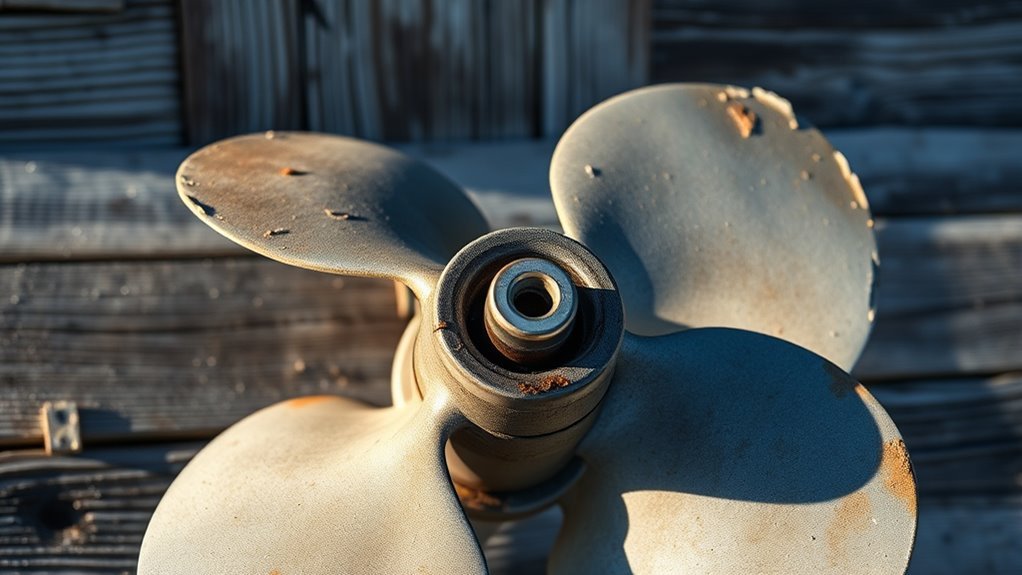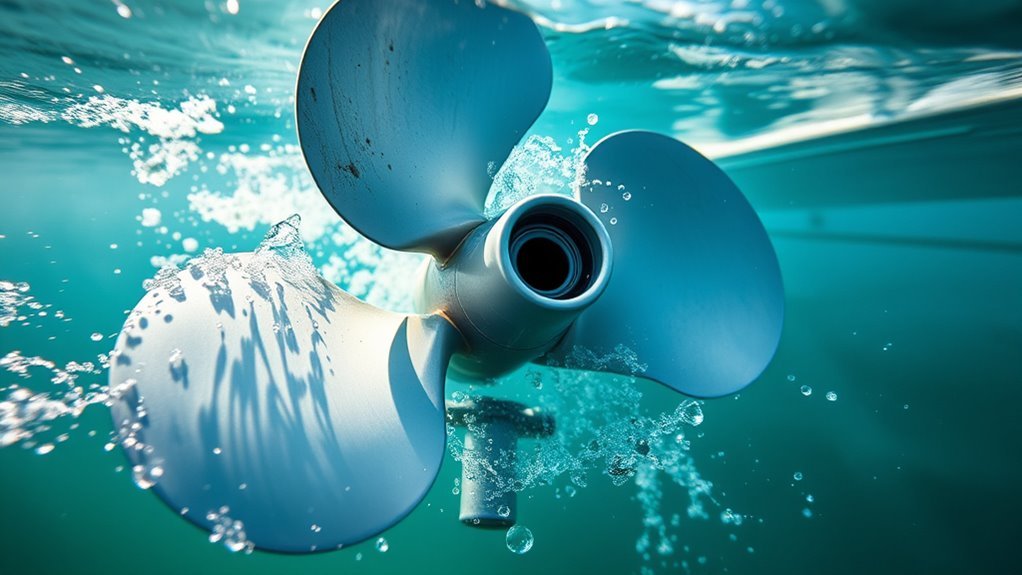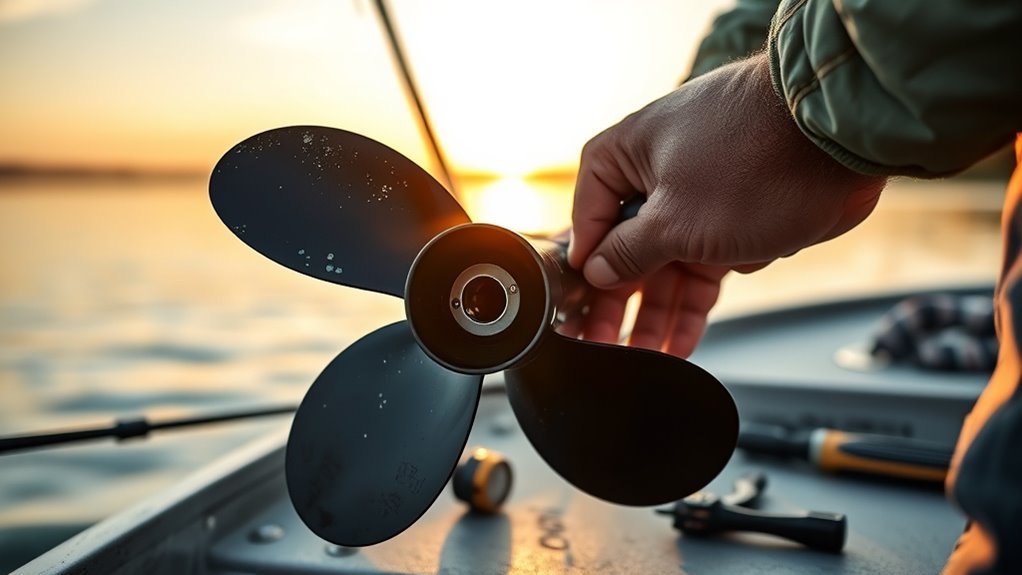We’ve all been there—your trolling motor starts acting like it’s had one too many at the marina bar. The thing’s vibrating, making weird noises, or just plain refusing to push your boat where you want it to go. Here’s the brutal truth: your propeller might be toast. Whether it’s bent blades, wrapped weeds, or performance that’s gone south, spotting the warning signs isn’t rocket science. But knowing what to do about it? That’s where things get interesting.
Visible Signs of Propeller Damage and Wear

Let’s be honest—your trolling motor propeller takes a beating out there.
And it shows.
A broken blade? That’s game over.
You’ll see it immediately, and your motor won’t function properly until you replace it.
Look for nicks and gouges too.
Rocks and debris love to leave their mark.
These battle scars reduce efficiency and create bigger problems down the line.
Watch for shaking during operation.
Could be weeds or fishing line wrapped around the blades, throwing everything off balance.
Or maybe the blades themselves are damaged.
Saltwater guys know the drill—corrosion is inevitable.
Rust and pitting eat away at performance.
When you spot it, replacement time isn’t far behind.
Additionally, bent blades can cause vibrations that signal the need for immediate attention.
Performance Issues That Signal Propeller Problems
Why does your trolling motor suddenly feel like it’s pushing through molasses? Your trolling motor prop might be screaming for help through performance issues you can’t ignore.
Notice a drop in thrust or power? That’s your first red flag.
Nicks and debris kill efficiency faster than you’d think.
Excessive vibration during operation? Classic propeller imbalance.
Try rotating the prop 180 degrees—sometimes it’s that simple.
Strange grinding noises aren’t mysterious boat sounds.
They’re bad news.
Spun hubs, bent shafts, rock damage—they all create interference and chaos.
Overheating happens when nicked blades collect weeds, frying electrical parts quickly.
Difficulty steering or controlling speed? Check for fishing line wrapped behind the prop.
Performance problems demand immediate inspection.
To prevent power loss, regularly perform propeller cleaning during maintenance routines.
Unusual Vibrations and Noises During Operation

When we’re out on the water and our trolling motor starts shaking like it’s having a seizure, there’s usually a reason – and it’s not because the fish are laughing at our technique.
The most common culprits behind these annoying vibrations are propeller imbalance and debris wrapped around the prop.
Props and shafts aren’t perfectly symmetrical from the factory, and when you add fishing line or weeds to the mix, you’ve got a recipe for vibrations that’ll rattle your teeth.
To minimize ongoing problems, regularly inspect and replace any worn drive pins as part of your maintenance routine.
Propeller Imbalance Causes
How does a perfectly good trolling motor suddenly start shaking like it’s having a seizure?
Welcome to the wonderful world of propeller imbalance.
Here’s the thing: props and shafts aren’t perfectly symmetrical.
Manufacturing creates inherent asymmetry that leads to vibrations.
It’s just physics being annoying.
But wait, there’s more.
Weeds and debris love accumulating on propeller blades.
This creates imbalance and those charming grinding noises we all adore.
Then there’s the bent prop shaft scenario.
Hit an underwater obstacle?
Congratulations, you’ve misaligned your propeller.
More vibrations, more grinding.
Sometimes minor manufacturing imbalances can be fixed by removing the prop, rotating it 180 degrees, and reinstalling.
If that doesn’t work?
You’ve got deeper problems like worn bearings.
For optimal performance, regular daily maintenance helps prevent such issues by ensuring the propeller remains free of debris.
Debris and Vibration
What’s that grinding noise coming from your trolling motor? Debris wrapped around your propeller is probably the culprit. Weeds, fishing line, and other junk love to tangle up your prop, throwing off its balance completely.
| Problem | Symptom | Quick Fix | When to Worry |
|---|---|---|---|
| Weeds wrapped | Vibration, grinding | Remove debris | If noise persists |
| Fishing line tangled | Unusual noises | Clean prop thoroughly | Bent shaft suspected |
| General debris | Motor overheating | 180-degree prop rotation | Worn bearings likely |
| Persistent issues | All of the above | Professional inspection | Damage beyond debris |
Remove your prop after each outing. Trust us, it’s worth the hassle. Even a Weedless Wedge Prop isn’t bulletproof against debris buildup. If rotating the prop 180 degrees doesn’t solve persistent vibrations, you’ve got bigger problems requiring professional help. To ensure long-term performance, always incorporate regular maintenance into your routine.
Weed Buildup and Debris Accumulation Problems
Among the most frustrating problems we’ll encounter with trolling motor propellers, weed buildup tops the list.
When weeds wrap around our prop, they cause violent shaking that screams “performance issues ahead.”
Nicks in the blades make it worse—they grab weeds like magnets.
Even those fancy “weedless” wedge props aren’t bulletproof; they’ll collect debris at higher speeds.
Here’s the kicker: if we don’t reverse or manually clear weeds immediately, our motor can overheat and burn out.
Fast.
Two motors dead from repeated weed problems? That’s expensive stupidity.
Regular inspection after every outing isn’t optional—it’s survival.
Hidden fishing line can destroy seals, letting water in.
Smooth those blade nicks with a file.
Your wallet will thank you.
Step-by-Step Propeller Inspection and Testing

Five minutes of proper inspection beats hours of frustration on the water.
First, disconnect the power source.
Always.
We can’t stress this enough—electricity and water don’t play nice.
Grab a 9/16-inch deep well socket and hold the propeller while loosening the prop nut.
Look for nicks, breaks, or debris wrapped around the shaft.
Fishing line loves hiding there.
Here’s a neat trick: rotate the removed propeller 180 degrees and reinstall it.
Sometimes props aren’t perfectly symmetrical.
This simple flip might eliminate vibration entirely.
Run the motor without the propeller attached.
Does the shaft turn freely?
If yes, your prop’s the culprit.
If no, you’ve got internal motor issues.
Either way, you’ll know where you stand.
Replacement Options and Maintenance Solutions
When your prop’s seen better days, we’ll need to talk replacement options—and trust us, not all props are created equal.
The maintenance game isn’t glamorous, but it’s what separates the pros from the weekend warriors who wonder why their motor sounds like a blender full of marbles.
Let’s cover choosing the right replacement and keeping your prop clean enough to actually do its job.
Choosing Correct Replacement Props
The right propeller isn’t just some random piece of metal you can grab off a shelf.
We need to stick with original Minn Kota replacement props—no shortcuts here.
Check your owner’s manual for the correct type.
The MKP-33 Weedless Wedge 2 Prop works for compatible motors, while the MKP-38 serves other models.
Aftermarket props? They’ll jack up your amp draw and potentially void your warranty.
Not worth it.
Here’s the harsh reality: if your desired prop kit isn’t listed in current options, it’s gone.
Period.
Verify everything through official Minn Kota resources before ordering your new prop.
These original replacements prevent overheating issues that aftermarket junk creates.
Trust us—spending extra upfront beats dealing with a fried motor later.
Regular Cleaning and Care
Consistently removing your propeller after every outing isn’t optional—it’s mandatory if you want your trolling motor to survive more than a season. Fishing line and weeds get caught behind the prop, damaging seals and killing performance. We’re not kidding around here.
Clean those blade nicks with a flat file. Sounds tedious? Wait until you’re dealing with motor failure from overheating because weeds kept building up on damaged blades.
| Maintenance Task | Frequency | Consequence of Neglect |
|---|---|---|
| Remove propeller | After every use | Seal damage, reduced performance |
| File blade nicks | As needed | Weed buildup, overheating |
| Check ring terminals | Regular inspection | Corrosion, binding issues |
| Torque prop nut | Every installation | Drive pin damage |
| Inspect for debris | After every use | Motor failure |
Tighten that propeller nut to 25-35 inch lbs—just 1/4 turn past snug.
Frequently Asked Questions
When to Replace a Trolling Motor Prop?
We’ll need to bid farewell to your prop when visible damage appears, excessive shaking occurs, or usage patterns show decreased efficiency from nicks and weed buildup affecting motor performance.
How to Tell if a Propeller Is Bad?
We can tell if a propeller’s bad by checking for visible damage like propeller cracks, nicks, or bent blades. We’ll also notice excessive vibration, grinding noises, or decreased motor performance during operation.
How to Tell if Your Trolling Motor Is Bad?
Studies show 40% of trolling motor failures occur from ignored warning signs. We can identify bad motor symptoms like reduced thrust, strange noises, steering difficulties, overheating, and excessive corrosion before costly repairs become necessary.
What Is the Life Expectancy of a Trolling Motor?
We’ve seen trolling motors last 10-15 years with proper care. However, storage effects like corrosion, debris buildup, and environmental damage can greatly reduce lifespan if you don’t maintain them regularly.